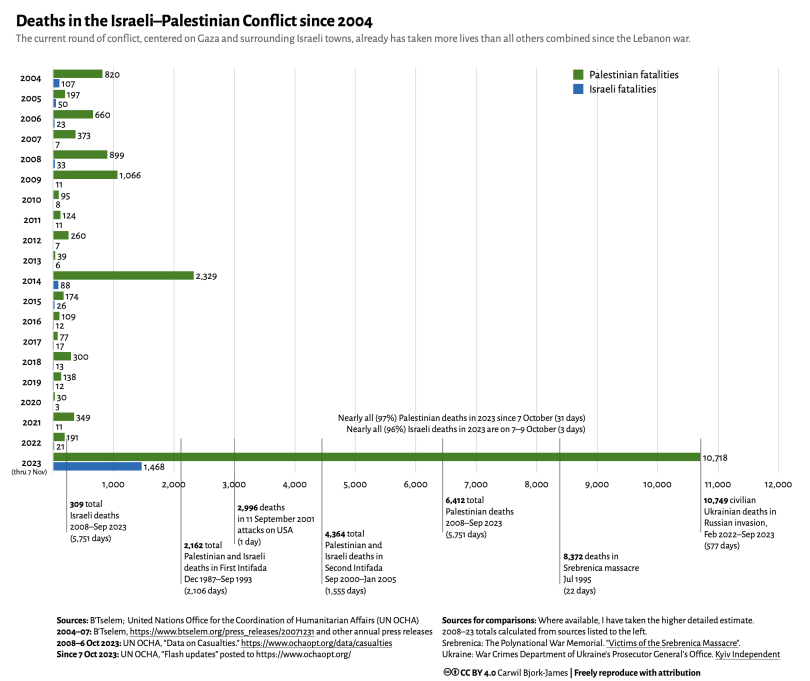This is not just another turn in the Israeli–Palestinian conflict.
The extraordinary attacks by Hamas on October 7 and the thirty-one days of bombardment and invasion by the Israeli military that followed have led to a loss of life on an historic scale in Israel and Palestine, respectively.
Researching and accounting for lethal political violence is a major part of my work, and I find myself staggered by this extraordinary and extraordinarily public burst of violence. Like climate scientists during this year’s record-breaking summer, I find myself frantically sharing statistics and re-posting and pointing out this is not normal. Not even against recent trends. That this is the threshold of something worse than what we’ve known.
That’s what I’m doing and feeling with these numbers coming out of Gaza. (And about October 7 in Israel, though it will be months before Hamas could credibly repeat that day of atrocity, while Israeli air strikes happen every day, and a prolonged occupation promises even worse.)
Making this graph is my attempt to show how this isn’t normal. To grapple with the historic significance of this moment. To not feel alone in seeing it.
To walk you through, we are seeing a level of violence that kills as many human beings in days as have died in many years of intense conflict. Read along the bottom axis and you’ll see that not only the deaths have already exceeded the First (1987–93) and Second Intifadas (2000–2005), and all the deaths since then in a half-a-dozen Gaza crises. As of now, all of these combined.
A week ago, the deaths in Gaza surpassed the 8,372 deaths in the July 1995 Srebrenica massacre in Bosnia, a loss of life that is remembered across the entire Muslim, with historic repercussions. It long since exceeded 9/11.
There are threats of forced expulsion of Gazans to Egypt, openly advocated by a military analyst in the Jerusalem Post, discussed by a planning ministry in the Israeli government, and proposed by Israeli diplomats to Egyptian officials. The expulsion of Palestinians in 1948 was accompanied by around 15,000 civilian deaths over many months. At current pace, that death toll would be passed before the end of November
Current best estimates are that at least 1,033 of the approximately 1,400 Israeli deaths were civilians; and somewhere between 80 and 90% of Palestinian deaths, translating to more than 8500 people, were civilians as well.
We know that over 4,000 Palestinian children have died, a toll that exceeds all reported wars since 2019. That comparison threw me back for a minute, and I’ve followed my doubts to re-read about the Tigray war (hundreds of child deaths), the Ukraine invasion (the 501st child death reported with outrage this summer), and so on. The repeated killing of entire families by destroying their still-occupied homes in Gaza is the qualitative difference. UNICEF, which must advocate for children everywhere, writes that Gaza has become a graveyard for them.
Day after day, the deaths pile up. Like a rising temperature, quantity eventually becomes quality. When the retaliation is large enough, it’s no longer a response, but its own historical event.
Enough cruelty on a large enough scale and even onlookers abroad may never see you the same way again. Enough killing means permanent distrust between two peoples who must either share a land or perish upon it. Enough massacre adds up to genocide.
It’s okay to not be okay right now.
It’s okay to say no to more of this.
It’s okay to stop fueling this fire with more weapons.
A PDF version of the chart is online.

